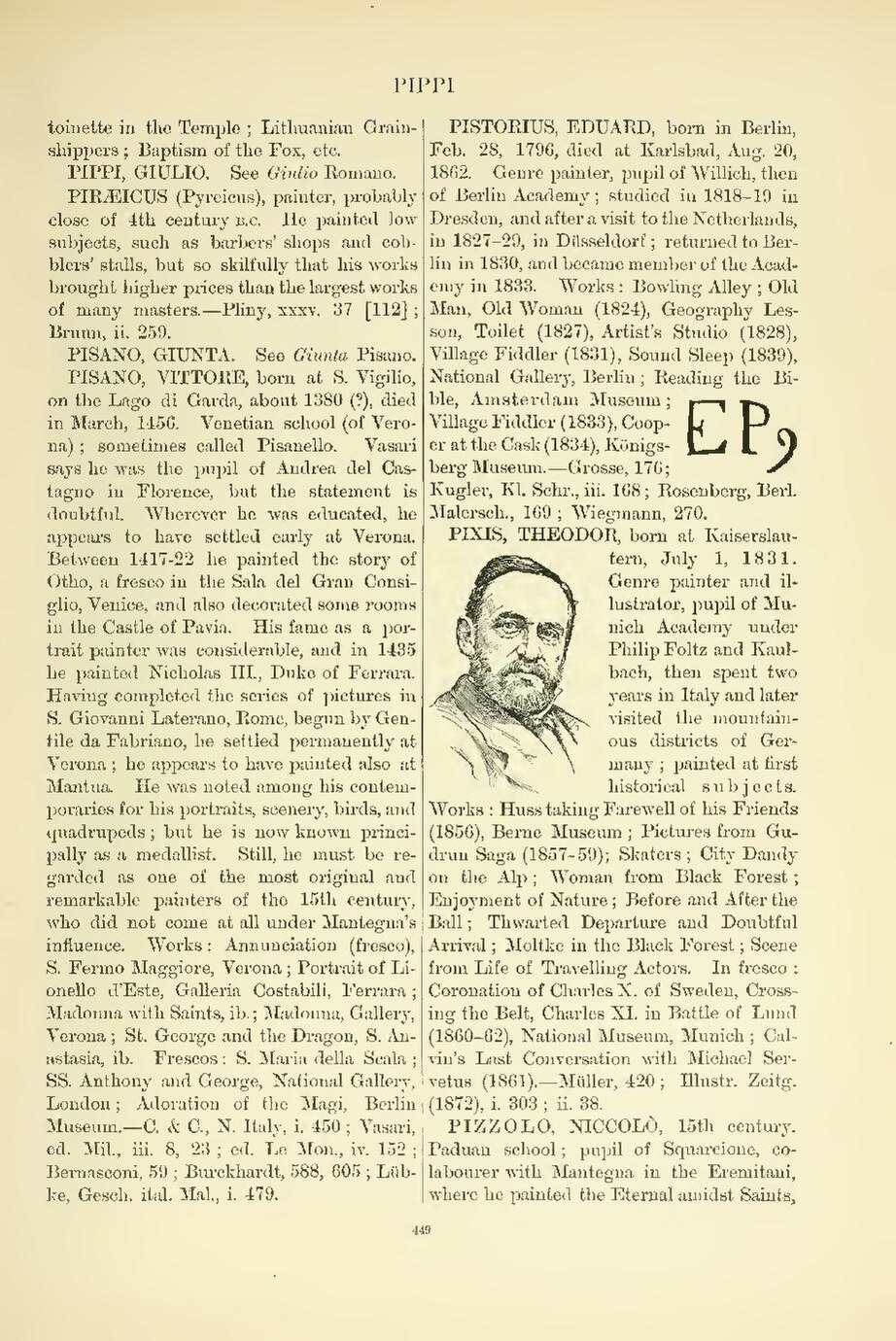- toinette in the Temple; Lithuanian Grain-*shippers;
Baptism of the Fox, etc.
PIPPI, GIULIO. See Giulio Romano.
PIRÆICUS (Pyreicus), painter, probably
close of 4th century b.c. He painted low
subjects, such as barbers' shops and cobblers'
stalls, but so skilfully that his works
brought higher prices than the largest works
of many masters.—Pliny, xxxv. 37 [112];
Brunn, ii. 259.
PISANO, GIUNTA. See Giunta Pisano.
PISANO, VITTORE, born at S. Vigilio,
on the Lago di Garda, about 1380 (?), died
in March, 1456. Venetian school (of Verona);
sometimes called Pisanello. Vasari
says he was the pupil of Andrea del Castagno
in Florence, but the statement is
doubtful. Wherever he was educated, he
appears to have settled early at Verona.
Between 1417-22 he painted the story of
Otho, a fresco in the Sala del Gran Consiglio,
Venice, and also decorated some rooms
in the Castle of Pavia. His fame as a portrait
painter was considerable, and in 1435
he painted Nicholas III., Duke of Ferrara.
Having completed the series of pictures in
S. Giovanni Laterano, Rome, begun by Gentile
da Fabriano, he settled permanently at
Verona; he appears to have painted also at
Mantua. He was noted among his contemporaries
for his portraits, scenery, birds, and
quadrupeds; but he is now known principally
as a medallist. Still, he must be regarded
as one of the most original and
remarkable painters of the 15th century,
who did not come at all under Mantegna's
influence. Works: Annunciation (fresco),
S. Fermo Maggiore, Verona; Portrait of Lionello
d'Este, Galleria Costabili, Ferrara;
Madonna with Saints, ib.; Madonna, Gallery,
Verona; St. George and the Dragon, S. Anastasia,
ib. Frescos: S. Maria della Scala;
SS. Anthony and George, National Gallery,
London; Adoration of the Magi, Berlin
Museum.—C. & C., N. Italy, i. 450; Vasari,
ed. Mil., iii. 8, 23; ed. Le Mon., iv. 152;
Bernasconi, 59; Burckhardt, 588, 605; Lübke,
Gesch. ital. Mal., i. 479.
An image should appear at this position in the text. To use the entire page scan as a placeholder, edit this page and replace "{{missing image}}" with "{{raw image|Cyclopedia of painters and paintings (IA cyclopediaofpain03cham).pdf/471}}". Otherwise, if you are able to provide the image then please do so. For guidance, see Wikisource:Image guidelines and Help:Adding images. |
PISTORIUS, EDUARD, born in Berlin,
Feb. 28, 1796, died at Karlsbad, Aug. 20,
1862. Genre painter, pupil of Willich, then
of Berlin Academy; studied in 1818-19 in
Dresden, and after a visit to the Netherlands,
in 1827-29, in Düsseldorf; returned to Berlin
in 1830, and became member of the Academy
in 1833. Works: Bowling Alley; Old
Man, Old Woman (1824), Geography Lesson,
Toilet (1827), Artist's Studio (1828),
Village Fiddler (1831), Sound Sleep (1839),
National Gallery, Berlin; Reading the Bible,
Amsterdam Museum;
Village Fiddler (1833), Cooper
at the Cask (1834), Königsberg
Museum.—Grosse, 176;
Kugler, Kl. Schr., iii. 168; Rosenberg, Berl.
Malersch., 169; Wiegmann, 270.
An image should appear at this position in the text. To use the entire page scan as a placeholder, edit this page and replace "{{missing image}}" with "{{raw image|Cyclopedia of painters and paintings (IA cyclopediaofpain03cham).pdf/471}}". Otherwise, if you are able to provide the image then please do so. For guidance, see Wikisource:Image guidelines and Help:Adding images. |
PIXIS, THEODOR, born at Kaiserslautern,
July 1, 1831.
Genre painter and illustrator,
pupil of Munich
Academy under
Philip Foltz and Kaulbach,
then spent two
years in Italy and later
visited the mountainous
districts of Germany;
painted at first
historical subjects.
Works: Huss taking Farewell of his Friends
(1856), Berne Museum; Pictures from Gudrun
Saga (1857-59); Skaters; City Dandy
on the Alp; Woman from Black Forest;
Enjoyment of Nature; Before and After the
Ball; Thwarted Departure and Doubtful
Arrival; Moltke in the Black Forest; Scene
from Life of Travelling Actors. In fresco:
Coronation of Charles X. of Sweden, Crossing
the Belt, Charles XI. in Battle of Lund
(1860-62), National Museum, Munich; Calvin's
Last Conversation with Michael Servetus
(1861).—Müller, 420; Illustr. Zeitg.
(1872), i. 303; ii. 38.
PIZZOLO, NICCOLÒ, 15th century.
Paduan school; pupil of Squarcione, co-*labourer
with Mantegna in the Eremitani,
where he painted the Eternal amidst Saints,
